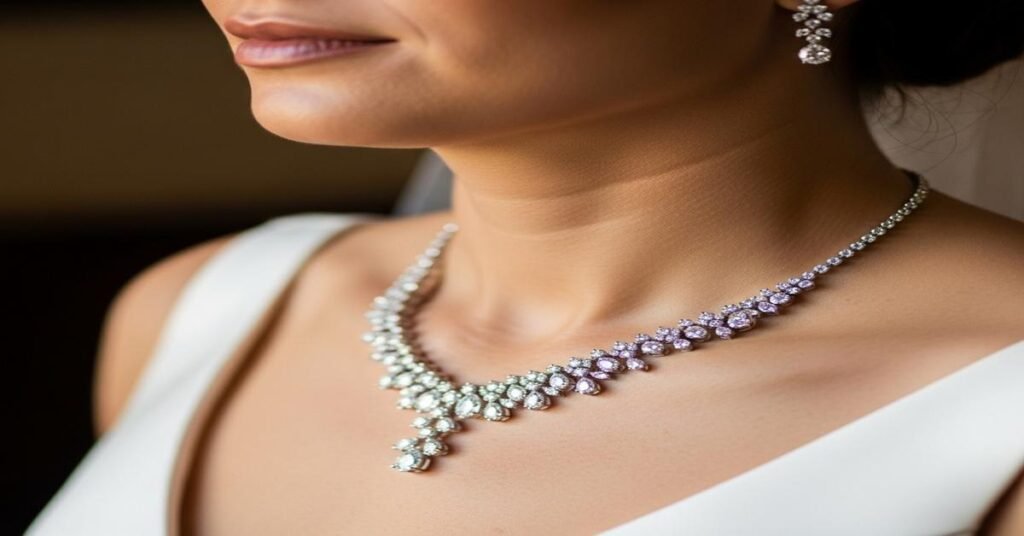Renting bridal jewelry is growing fast because it solves a clear problem: most brides want show-stopping pieces for one day, but paying full retail for items worn once often makes little sense. Renting gives access to high-quality diamonds, designer pieces, and vintage heirloom styles without the long-term cost. Below I explain how renting works, why it saves money, when it makes sense, what to watch for, and practical tips so you get a perfect look without surprises.
How renting bridal jewelry actually saves money
Rental pricing is based on short-term use. Companies typically charge a fraction of retail — commonly 3–10% of an item’s retail value for a weekend, or a flat daily/weekly rate. That means a necklace retailing for $10,000 might rent for $150–500 for a wedding weekend. The math is simple: if you would only wear a piece once, renting avoids the 10x–100x cost-per-wear you’d get from buying.
Beyond sticker price, renting reduces other costs: you avoid long-term insurance premiums, high jewelry repair bills, and the pressure to resell after the wedding at a loss. Renting also lets you choose higher-quality materials — real diamonds, platinum settings — for far less than buying the same piece.
What kinds of pieces are best to rent
Rent items you’ll only wear once or rarely. Common rental picks:
- Statement necklaces — large pendants or multi-strand pieces that define your look.
- Tiaras and hairpieces — often designer or vintage and costly to buy outright.
- Earrings and bracelets — matching sets for photos and the reception.
- Designer or vintage rings — for engagement or proposal rings some couples rent a ring to surprise, then later buy a permanent band.
Renting an engagement ring for the proposal is popular if you want a memorable stone without committing to a specific style or cost. Note: rental rings may not be resizable, so you’ll likely need to plan for fit.
Know the quality and size specifics
Ask for exact specs so you get the look you expect. Useful numbers:
- Carat and millimeter sizes — for round brilliants: 0.5 ct ≈ 5.1 mm, 1 ct ≈ 6.5 mm, 2 ct ≈ 8.2 mm. For oval/emerald cuts, mm dimensions vary more; ask the vendor.
- Metal composition — 14k gold is about 58.3% gold, 18k is 75%, platinum is usually 90–95% pure and heavier. White gold will have rhodium plating that can wear over time.
- Stone type — lab-grown diamonds look identical to mined diamonds but cost less; moissanite and cubic zirconia (CZ) are brighter or less expensive alternatives. Ask for GIA or other lab reports for diamonds.
Why numbers matter: a 1 ct round looks very different from a 2 ct; a silver-toned setting paired with a yellow gold wedding band can look mismatched. Get measurements and photos on a model or with scale references.
Practical timeline and logistics
Book early. Popular styles and designer pieces go fast around peak wedding seasons. Recommended timeline:
- Reserve 2–3 months before the wedding.
- Finalize selection and confirm sizing 4–6 weeks out.
- Request delivery 3–7 days before the event to allow for inspection and minor adjustments.
Inspect immediately on arrival. Most rentals include a condition report; photograph the piece with the vendor’s serial number or paperwork to document condition on receipt.
Insurance, deposits, and contract details
Read the rental agreement closely. Key terms to check:
- Security deposit — often refundable and sized to the retail value.
- Damage and loss policy — some companies require you to buy a short-term insurance policy; others charge replacement value for loss or repairs.
- Late fees and return windows — missing the return date can trigger hefty daily fees.
- Shipping insurance — verify who bears responsibility during transit and whether signature delivery is required.
Check whether your own renter’s or homeowner’s insurance covers rented jewelry. If not, buying the vendor’s insurance for the rental period is usually worth it; deductibles commonly range $250–$500.
Style tips for getting the most impact
Choose pieces that complement, not compete with, your dress. Specifics that help:
- For strapless or sweetheart necklines, pick a pendant 18–45 mm wide or a 0.75–2 ct center stone necklace for balanced proportion.
- If your dress has heavy beading near the neckline, use simple stud earrings (0.25–0.75 ct per stud) rather than a large necklace.
- Match metal tones to your wedding band—if uncertain, pick pieces in platinum or 14k white gold for neutral pairing.
- Try photos with and without the piece under wedding lighting to confirm the effect; diamonds reflect differently in warm incandescent light versus daylight.
Care and return best practices
Handle jewelry like fine china: put it on last, take it off first. Keep it dry and away from hairspray, lotion, and perfume during wear. Clean gently with mild soap and a soft brush before returning, unless the vendor requests professional cleaning. Always return in the provided case and with the condition report to avoid disputes.
Final decision checklist
- Compare rental cost vs. buying — include insurance and potential resale loss.
- Get precise carat, mm, and metal composition details.
- Confirm fit and reserve early; allow time for delivery and inspection.
- Review insurance, deposits, and damage policies in writing.
- Photograph condition at pickup/delivery and before return.
Renting bridal jewelry is a practical way to wear higher-end, unique, or designer pieces without long-term cost. If you plan ahead, know the specs, and read the contract, you can get a tailored, polished look for your wedding day while keeping most of your budget for the marriage that follows.
I am G S Sachin, a gemologist with a Diploma in Polished Diamond Grading from KGK Academy, Jaipur. I love writing about jewelry, gems, and diamonds, and I share simple, honest reviews and easy buying tips on JewellersReviews.com to help you choose pieces you’ll love with confidence.

